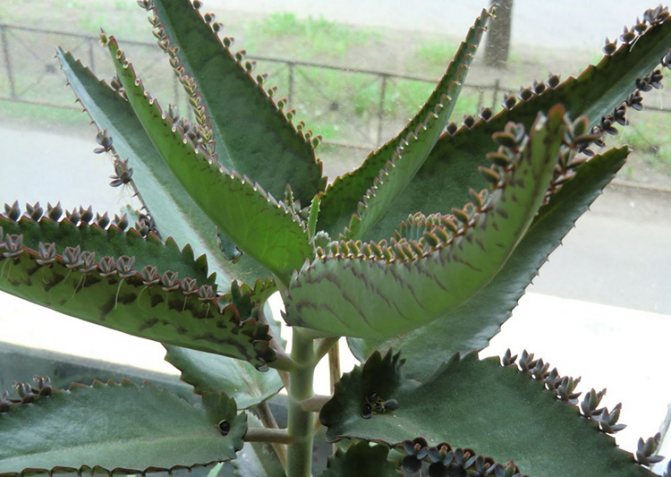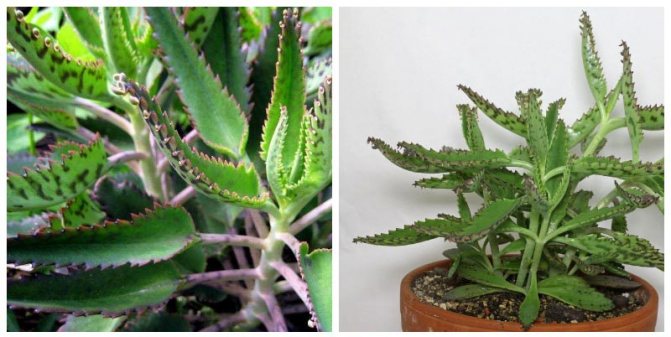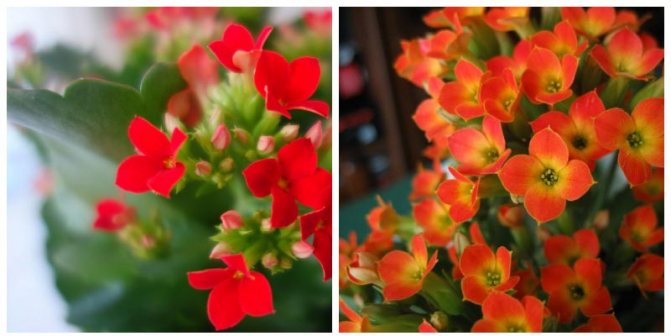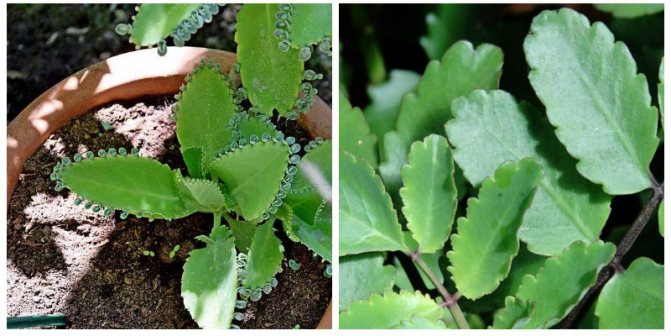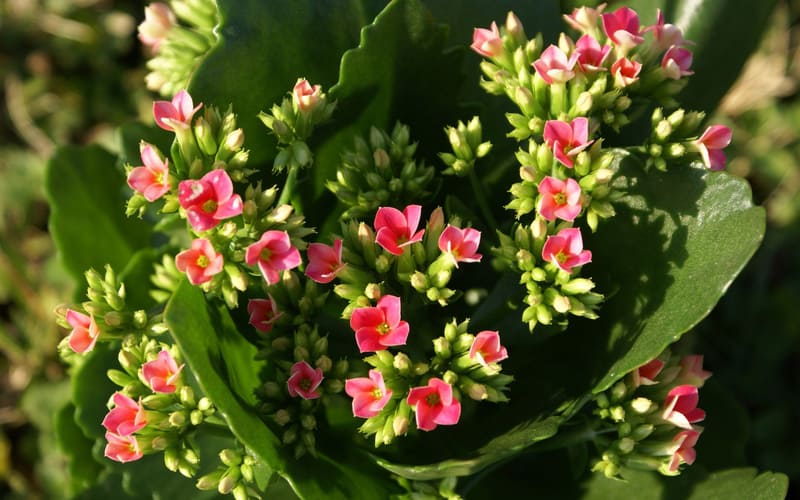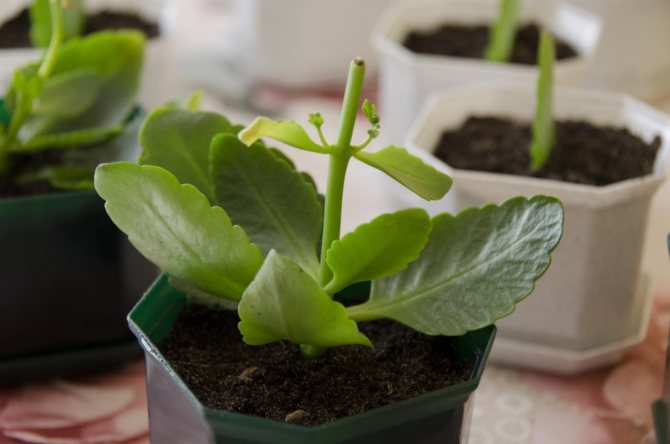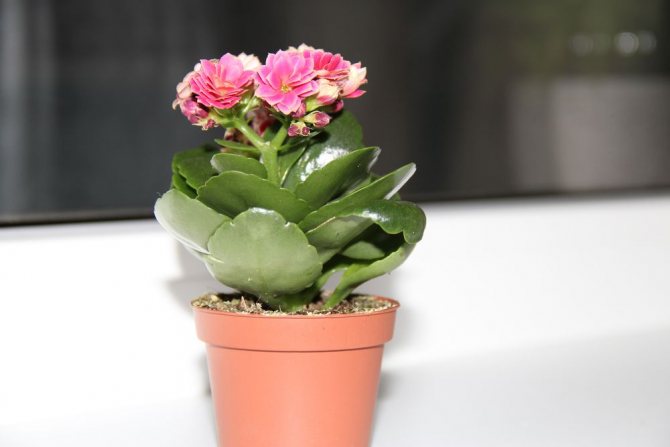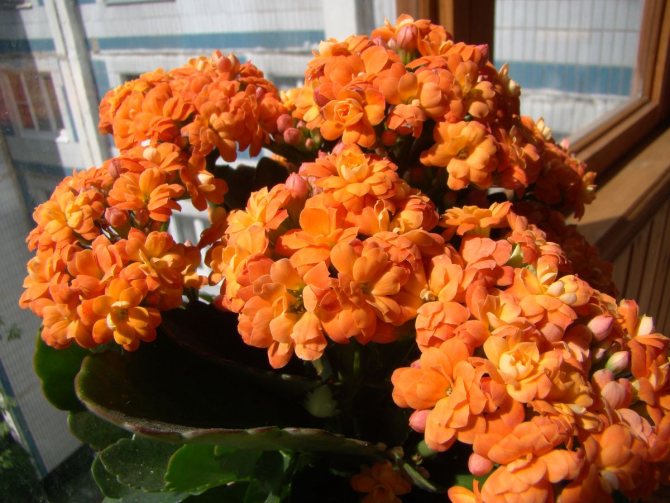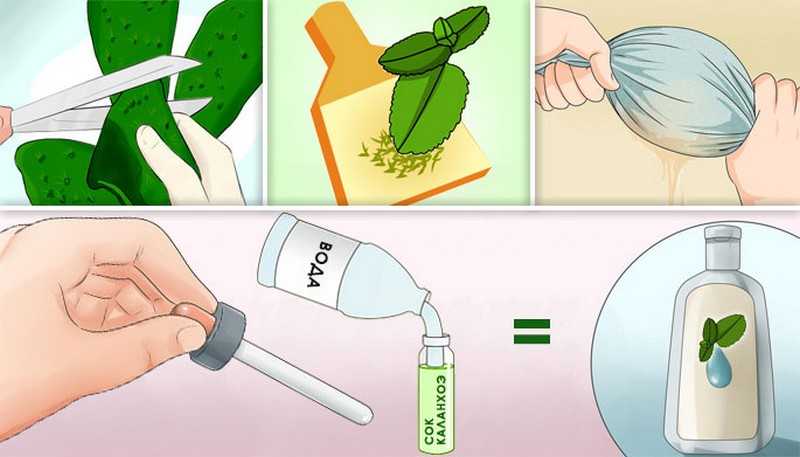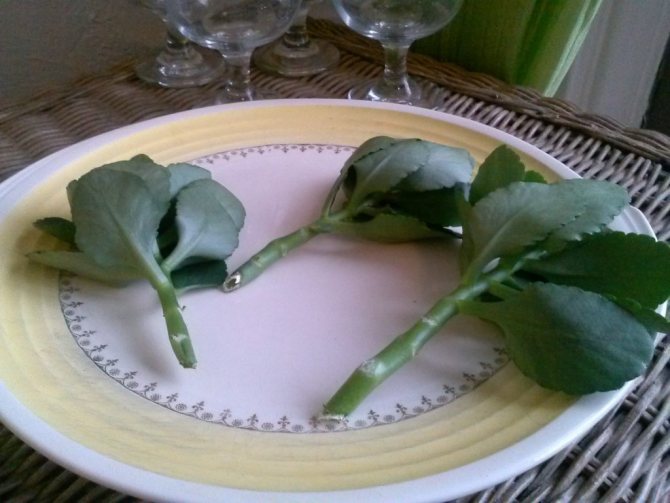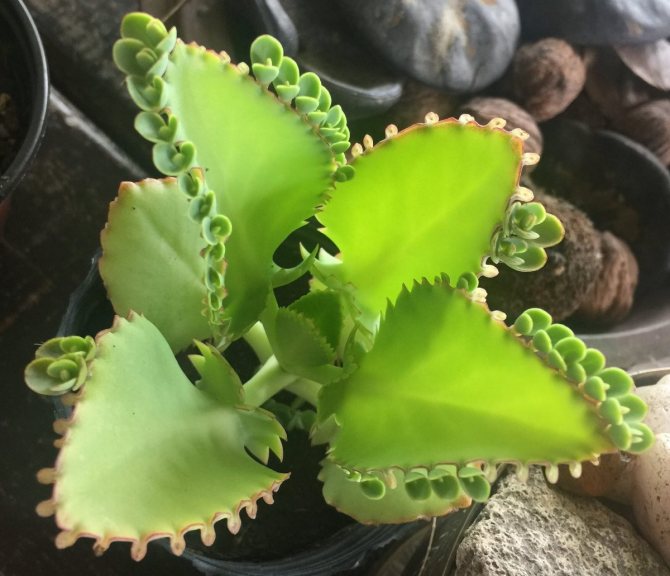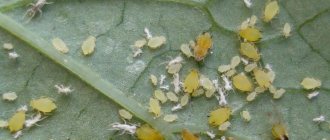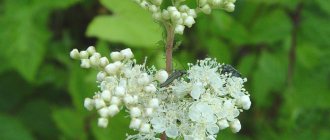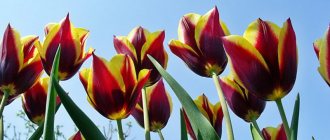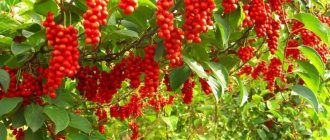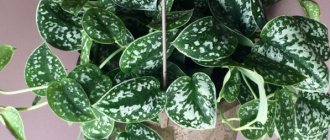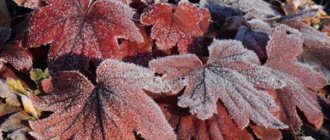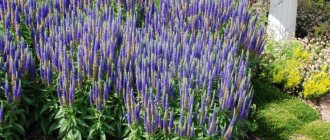This flower can be found in almost every apartment. Kalanchoe juice has medicinal properties and is used in medicine. The plant is popularly named as Homemade Ginseng, the Tree of Life. Kalanchoe is very hardy and not fastidious, capable of growing in any conditions, even if mistakes are made in care. But this does not mean that the plant does not require maintenance at all. A well-groomed Kalanchoe will delight you and serve as a decoration in the house. Kalanchoe types of photos and names, medicinal properties are described in this article. you can use the menu below for easy navigation.
The plant belongs to the succulent family and is able to accumulate water in the leaves and stems. His close relative is a fat woman. Kalanchoe is called the Tree of Life, and the fat woman is called the Money Tree. Very often Kalanchoe is confused with aloe, but these are completely different plants, they belong to other families.
Why Kalanchoe stretches and does not bloom
Kalanchoe does not require a lot of light. In the summer, the flower will be better on the east and west windows, and in the winter on the south. If the Kalanchoe is under the scorching rays of the sun, it can get burned, so it needs to be shaded. If he does not have enough light, the plant will stretch out, and its flowers will become small.
The condition for flowering Kalanchoe is twelve hour daylight hours. If you want the flower to bloom constantly and profusely, then you need to comply with the conditions, shade it in the summer and increase the daylight hours in winter and autumn using artificial lighting.
In summer, Kalanchoe tolerates heat of 30 degrees and above very well. In winter, it loves coolness (16-18 degrees Celsius). This temperature contributes to the formation of flower buds. If the temperature is higher or lower, the process of laying the kidneys will be slow. The flower is indifferent to air humidity. He will also be good in a room with dry air. It will easily tolerate high humidity, but still do not refuse to spray.
Although Kalanchoe belongs to the succulent family, it must be watered regularly. Watering the plant depends on the air temperature, the size and condition of the flower. In summer, when it is hot and dry, abundant watering is required. Water the flower two to three times a week, in winter, watering is reduced.
You can make the soil for the Kalanchoe yourself, take leaf and sod land in equal parts, add peat and sand. You can also add charcoal and perlite. Place drainage on the bottom of the pot. And if you do not want to waste time on this, buy ready-made soil for succulents at the flower shop.
Once every two weeks, from mid-May to the second half of July, you need to feed. Fertilizers are suitable for any cacti. Top dressing is continued in late autumn during the formation of flower buds.
A Kalanchoe transplant is needed if the pot in which the flower grows is too small. It happens that, due to excess watering, the earth becomes clumsy, in this case it must be replaced.
In order for the Kalanchoe to please with its beauty, you need to trim and pinch. Pruning is carried out in the spring, the shoots that are stretched are shortened by two-thirds. At the beginning of summer, a pinch is done, especially a young Kalanchoe needs it.
Reproduction
Reproduction of Kalanchoe is not difficult. These plants are so tenacious that their segments that have fallen off often take root on their own, without outside help. This is especially true of viviparous species - to get young animals, it is enough to put the babies on wet ground. They will quickly take root and grow.
Most often, propagation by cuttings is used at home. Use the tip of the shoots, specially cut or left after spring pruning. They should be no shorter than 6-8 cm. Without preliminary processing, they are placed in a mixture of sand and leafy soil, covered with a bag or jar. Water as it dries. The roots appear after a few weeks. After rooting, the cutting is pinched to stimulate branching. This method is well suited for Kalanchoe Mangin, Blossfeld and its hybrids.
Leaf propagation is used only for species with juicy, fleshy leaf plates. They are cut off in summer, petioled down into a mixture of earth and sand, and greenhouse conditions are created. Paniculate-flowered Kalanchoe can be propagated by buds. The axillary bud is located just above the leaf and resembles a head of cabbage. After the leaf falls off, a lateral shoot begins to form from it. When it reaches 1–2 cm in length, it is cut off along with the kidney. Grown as a cutting.
Felt and feathery Kalanchoe can be propagated by seeds. The optimal time for planting is late winter - early spring. Kalanchoe seeds are sown in a mixture of leafy soil and sand superficially, lightly pressing down with a finger. The seedlings need greenhouse conditions, the temperature is about 20 degrees. If necessary, moisten the soil with a spray bottle with warm water. Seedlings appear within a week. A month later, they are dived for the first time, seated in more spacious containers. At the second pick - after the appearance of 3-4 true leaves - the seedlings are planted in several pieces in small pots, pinched and put in a permanent place.
What to do to make the Kalanchoe bloom
If your plant does not bloom, provided that you have properly looked after and maintained it, then try to reduce the amount of fertilizer applied to the soil. The fertilizer application must be suspended, gradually reducing the amount. The most famous reason for not blooming Kalanchoe is the high content of fertilizers in the ground. The inflorescences must be removed as soon as the flowers wither. If pruned in time, this will awaken new flowering stems and extend flowering until mid-summer. Kalanchoe refers to re-blooming, but this is not so easy to achieve, and therefore it is often thrown away as soon as the flower has faded.
Can the Kalanchoe be planted outside
In the summer, the Kalanchoe will feel good outdoors in the open field. Also, a flower in a pot can be taken out to a balcony or terrace.
At what time of the year is it done
When Kalanchoe blooms - how often at home
The plant can be transplanted into open ground in the summer, like any other indoor flowers, the succulent will respond positively to a change of scenery. For a flower, you can choose a dry place where direct sunlight rarely looks. If the Kalanchoe is blooming, the plant will perfectly decorate the flowerbed.
For your information! Indoor flowers tolerate a summer transplant well, but it is advisable to prepare the plants for the open sun. In direct sunlight, the leaves will burn, and if the snap gets cold, the roots will suffer.
Features of Kalanchoe care in the open field
It is recommended to gradually accustom succulents to the sun and fresh air. For example, on the first day, a flower with a pot can be taken out for an hour, then the time can be increased by two hours. It is important to repeat the procedures daily with a gradual increase in the time of exposure to the sun.
Important! Do not keep indoor flowers in the open field until it gets cold. They are very picky about temperature changes.
How Kalanchoe blooms photo
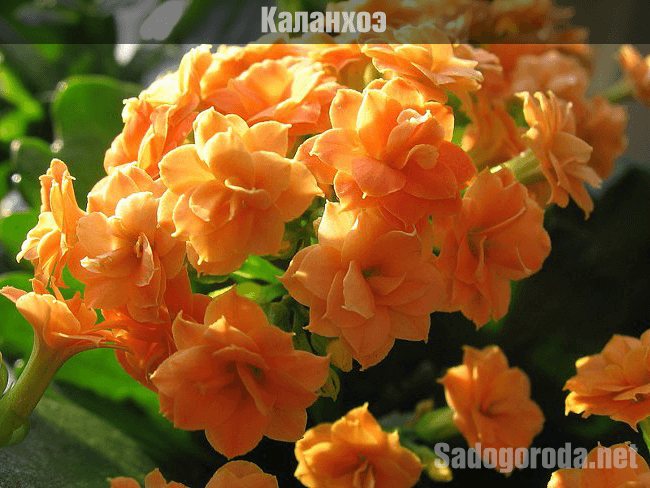
What to do to make the Kalanchoe bloom
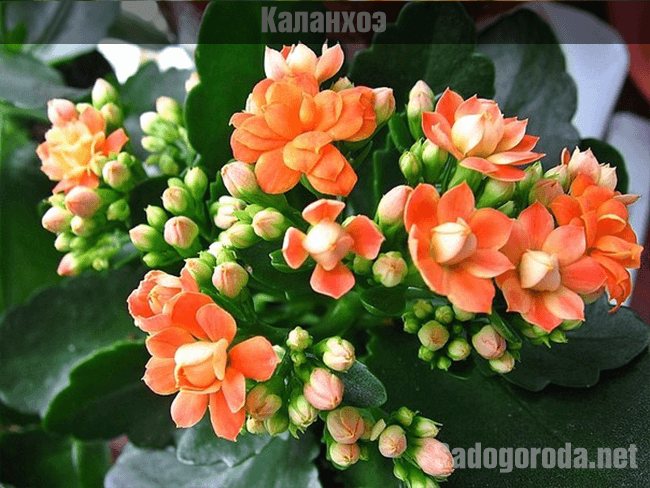

What to do to make the Kalanchoe bloom


What to do to make the Kalanchoe bloom
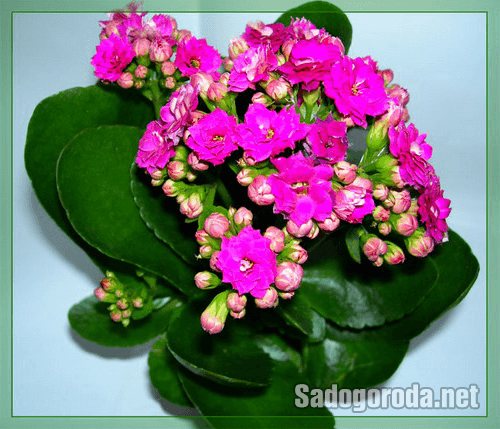

What to do to make the Kalanchoe bloom
Kalanchoe pests and their treatment with photos
Aphids on Kalanchoe how to get rid of
Aphids are the plant's worst enemy. Small, green insects can be seen on the leaves and stems that prevent nutrients from entering. If you notice that the leaves began to turn yellow and fall off, then the aphids have chosen your flower. Those areas that are affected by aphids must be cut off and burned. And treat the remaining parts with laundry soap, avoiding contact with the ground.
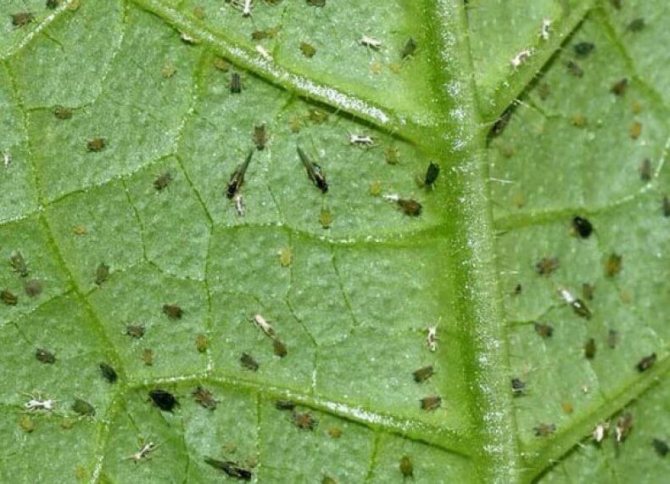

Shield on Kalanchoe
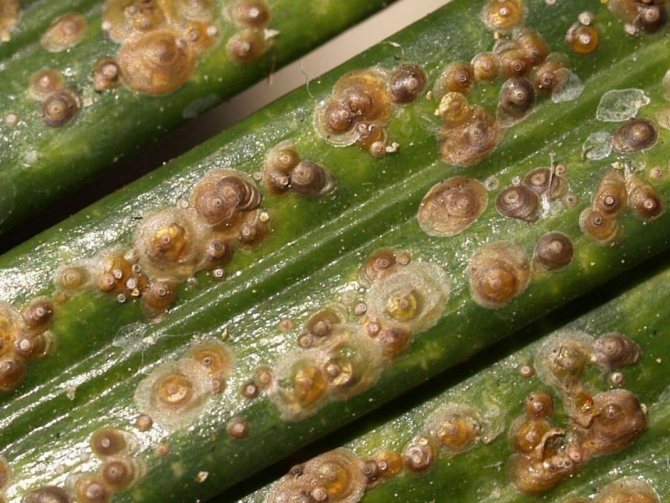

Kalanchoe is covered with a gray or brown bloom of insects, this is a scale insect. It secretes mucus, because of this, the condition of the flower worsens, it stops blooming. To remove the scabbard, you need to apply an alcohol solution. Carefully remove insects with a brush and wipe the places where the scabbard was found. The medicine in which there is alcohol is suitable for processing. Kalanchoe will recover soon.
How to root Kalanchoe
To root the Kalanchoe, the stalk must be cut from a young shoot so that at least three leaves remain on. After the cutting has been cut, place it in the water. It will take root faster in this way and it will be easier for you to follow it. As soon as the roots are two to three centimeters, the cutting is planted in the ground, which is suitable for Kalanchoe.
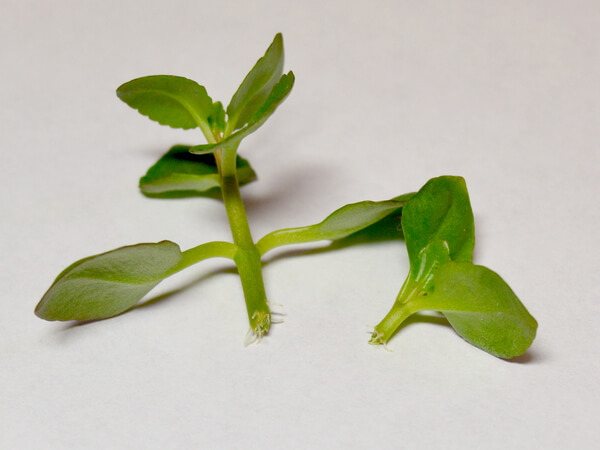

How to root Kalanchoe
Kalanchoe medicinal properties
More than two hundred species of Kalanchoe are known. But blooming Kalanchoe has no medicinal properties. The most common, which are used for medicinal purposes, are Kalanchoe Peristoe and Degremona. They contain many vitamins, organic acids, trace elements. The plant is used in the treatment of various diseases; creams, ointments, tinctures are made on the basis of Kalanchoe.


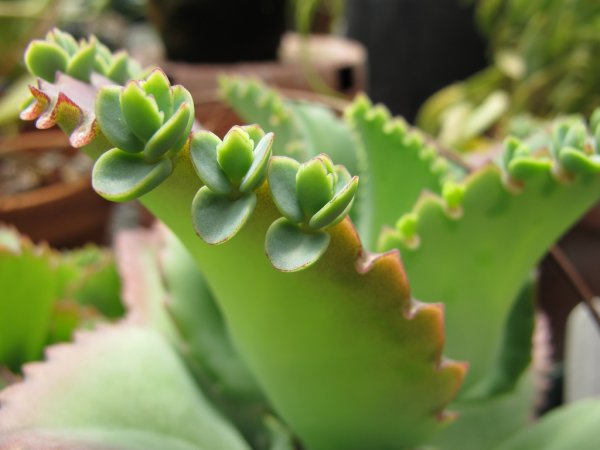

The stems and leaves are used for medicinal purposes. Juice, ointments, tinctures treat: ear disease, skin diseases, inflammatory diseases, oral diseases, colds, eye diseases, as well as tuberculosis, kidney disease, stomach ulcer, arthritis, arthrosis. Kalanchoe-based medications can be bought at the pharmacy, or you can prepare yourself.
Nuances of flowering plants
The Kalanchoe bloom is repeated annually. A scattering of inflorescences appears from mid-January to March. With proper care, flowering is extended throughout the summer.
A period of activity and rest
The first wave of budding occurs in March. New flower buds are laid after the timely removal of dried flowers. Also Kalanchoe must be provided with feeding.
With good agricultural technology and optimal keeping conditions, the flower is replete with flowers for a very long time. If the bush does not lay buds, the reason lies in improper care, and infection with diseases is also possible.
Types and shape of flowers
Kalanchoe is a flower that differs in shape and color, it is white, yellow, pink or red. The flowering varieties are quite interesting and unusual. The shape of the buds is also different. For example, in some varieties, flowers are bells, which are collected in panicles. Peduncles are long.
Other species are distinguished by the presence of long arrows with bunches of small flowers. There are species with bunches of inflorescences that stay on the plant for a very long time, up to 3 months. Terry Kalanchoe is very beautiful, the flowers of which look like small roses in a bouquet. Terry species are distinguished by larger and more varied flowers.
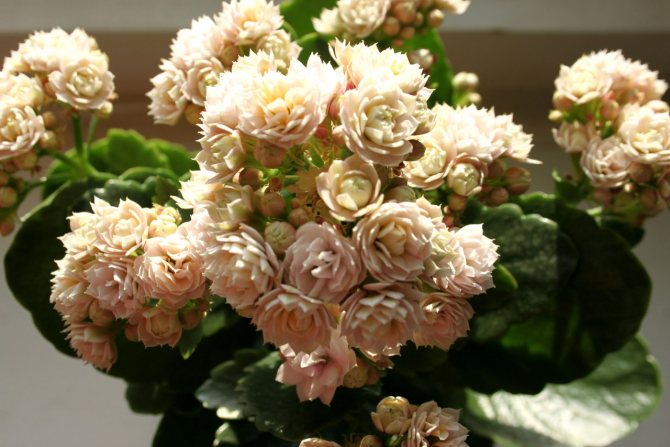

Terry Kalanchoe
Application of Kalanchoe leaves
The use of Kalanchoe leaves is not at all difficult. Cut the leaves off and rinse in water, let the water drain. Then wrap the leaves in newspaper and put in the refrigerator for a week. After the lapse of time, the leaves need to be crushed, it is advisable to do it by hand.When the Kalanchoe is crushed, we put it on cheesecloth, which must be folded in four and squeeze out the juice. Put the finished juice in the refrigerator for a day to precipitate. Strain the juice through cheesecloth and transfer to a dark jar. Store no more than two weeks.
Kalanchoe infusion on alcohol
You can prepare a tincture for this you need to take one part of the juice and five parts of 70 percent alcohol. drain into a dark bottle and close tightly. The shelf life is no more than a year. During the flu, use Kalanchoe juice for prevention. For children, it must be diluted with water one in five, for adults it should be used without dilution. It is necessary to lubricate or bury it in the nose. If you have a runny nose, rinse your nose and drip the diluted juice as soon as there is nasal congestion.
If you wish, you can prepare an ointment. To do this, you need to pour thirty grams of Kalanchoe juice into a container, add fifty grams of lanolin, you can buy it at a pharmacy. You can use pork fat or goose fat, some use top quality butter. Heat until completely dissolved, without allowing to boil. After cool, store in the refrigerator.
The ointment is used for eczema, purulent wounds, psoriasis. Also used for bedsores, skin rashes, frostbite.
Kalanchoe water infusion
Kalanchoe is crushed and placed in a container, filled with water and placed in a water bath for twenty minutes. If the infusion is applied externally, take one part of Kalanchoe and five parts of water. For indoor use, the ratio is one to ten. Then the broth is filtered. The broth is filtered and boiled until it is halved.
Used in the treatment of tuberculosis, in gynecology, for diseases of the digestive system.
There is an opinion among the people that the Kalanchoe cleans the air in the room from bacteria and viruses. Brings peace and tranquility to the house.
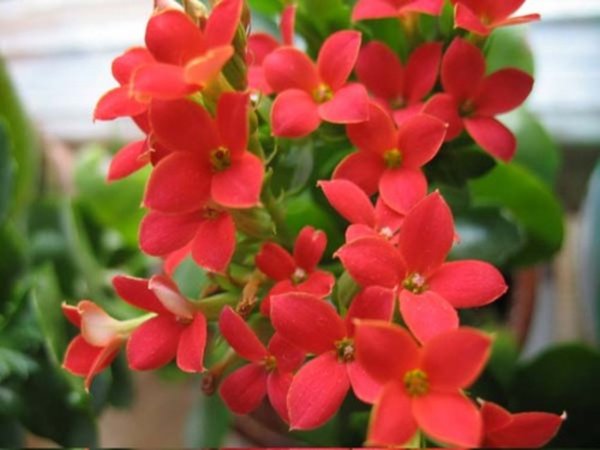

Medicinal properties and contraindications
The plant is characterized by a varied chemical composition. The leaves contain: magnesium, zinc, aluminum, iron, ascorbic, tannic acid, polysaccharides.
The flower has a variety of medicinal properties:
- anti-inflammatory;
- antiseptic;
- antibacterial, antifungal;
- strengthening the protective functions of the body;
- activation of the process of tissue regeneration, wound healing, burns;
- promotes rapid blood clotting;
- normalizes cholesterol levels;
- helps to cleanse the blood;
- improved blood circulation;
- has a choleretic effect;
- it has an analgesic effect;
- slows down aging;
- tones up, restores vitality.
The plant is characterized not only by medicinal properties, but also by contraindications. It is not recommended to use it when:
- individual intolerance;
- while carrying a child;
- lactation;
- low blood pressure;
- neoplasms;
- treating young children;
- joint diseases;
- dysfunctions of the liver, gastrointestinal tract.
Improper use of the plant can lead to the development of an allergic reaction, diarrhea, skin rashes, burning sensation.
Interesting: The use of ginkgo biloba, the benefits and contraindications of the plant
Kalanchoe varieties with names with photos
Below we have selected the most popular Kalanchoe varieties with names and photos.
Kalanchoe terry photo


Terry Kalanchoe plant blooms in bright pink color. It has oval, dark green leaves with a double structure. For him, a temperature regime of 18-22 degrees is important, regardless of the season. It does not need spraying, it is enough that the room is ventilated.
Description and photos of varieties that produce buds
Kalanchoe is an evergreen perennial, belonging to the group of succulents, the jungle family. A plant can be recognized by the following external features:
- has a small or medium bush height;
- has elastic large leaves with a fleshy structure and uneven edges;
- during flowering, a dense carpet of inflorescences consisting of small flowers, the color of which varies from white to rich red tones, forms on the plant.
To date, about two hundred varieties of Kalanchoe are known... The most common and popular species among florists are.
Blossfeld
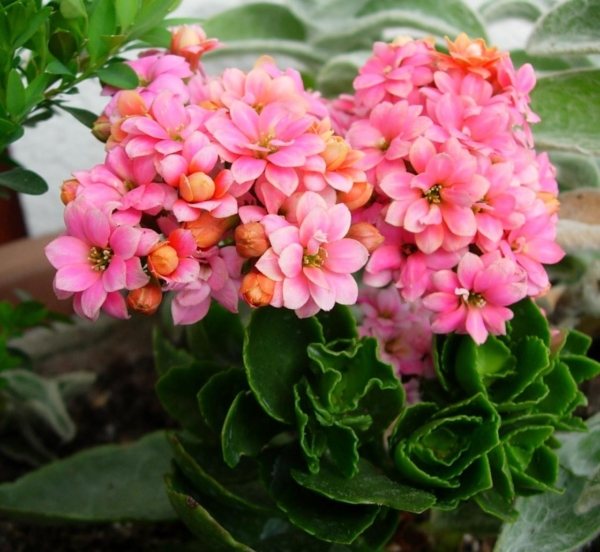

It has a height of up to 45 cm, rounded leaves with wavy edges and a smooth waxy surface, brightly colored flowers in the form of stars, collected in umbrella inflorescences.
Video about Kalanchoe Brossfeld:
Kalandiva
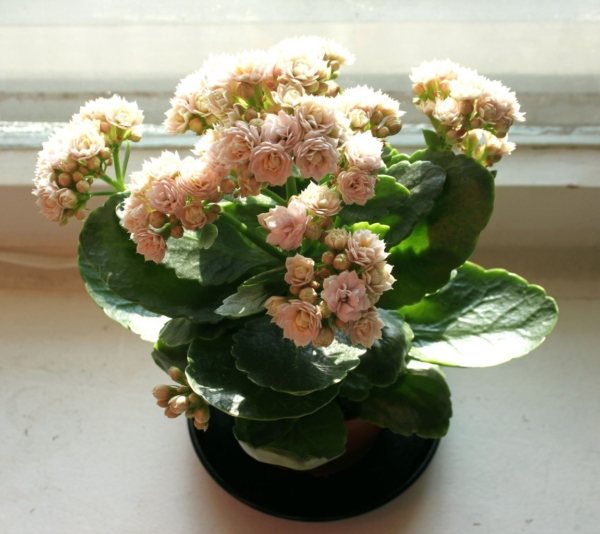

Refers to dwarf, the height of the spreading bush does not exceed 20 cm, at the ends of the shoots during the flowering period, dense inflorescences of flowers of two shades appear.
Video about Kalanchoe Kalandiva:
Kalanchoe mix photo
.
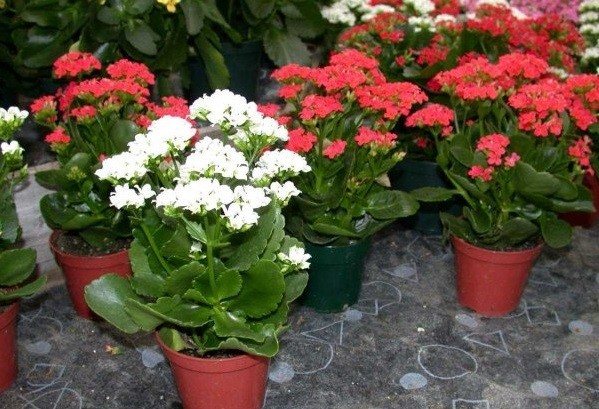

Kalanchoe mix differs from others in its abundant flowering, which lasts more than ten weeks. Unpretentious care. He loves light very much, you can put it on the sunny side without fear. In the summer, you need to feed with fertilizers, once every two weeks. Water moderate to abundant in summer and spring, twice a week in winter. After flowering, the stems need to be pruned to give the plant a beautiful look.
How to care for a non-blooming Kalanchoe at home
Growing viviparous and succulent species is somewhat different from caring for Blossfeld's Kalanchoe and its hybrids:
- They need less moisture. In winter they water it 2-3 times a month, in summer they let the soil dry well.
- You can pinch the stretched and bare shoots at any time; as they grow, they constantly lose the lower leaves.
- The pots can be placed not only on the south, but also on the west or east windows.
- Fertilizers are applied 3-4 times a year, in the spring and summer. Use universal dressings at a concentration half that indicated on the package, or special mixtures for succulents.
In general, these species are more resilient and require less attention.


